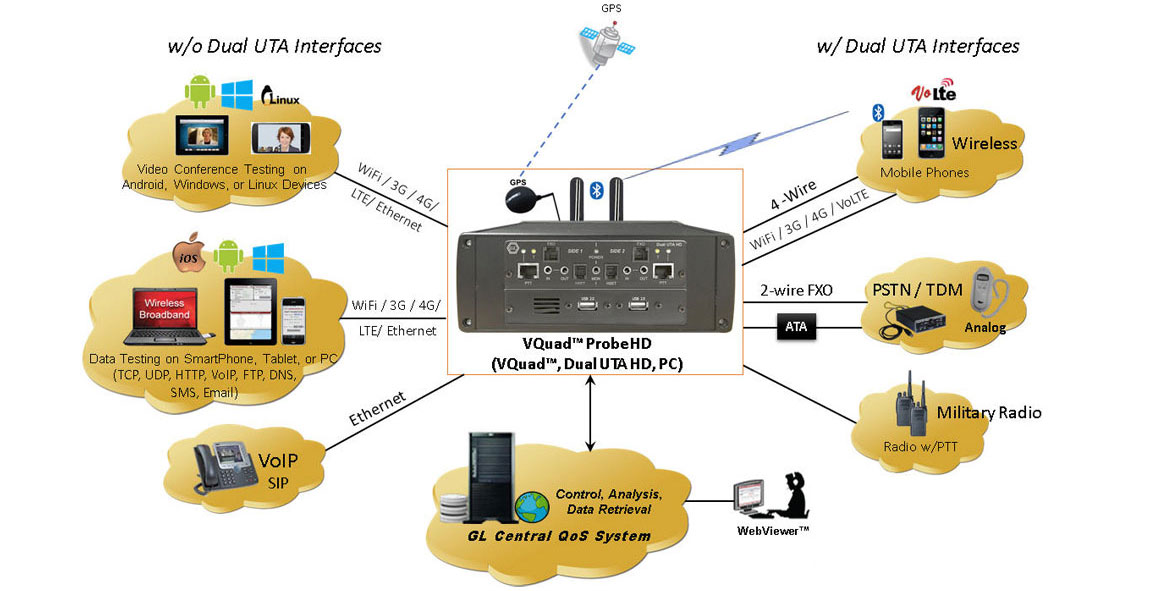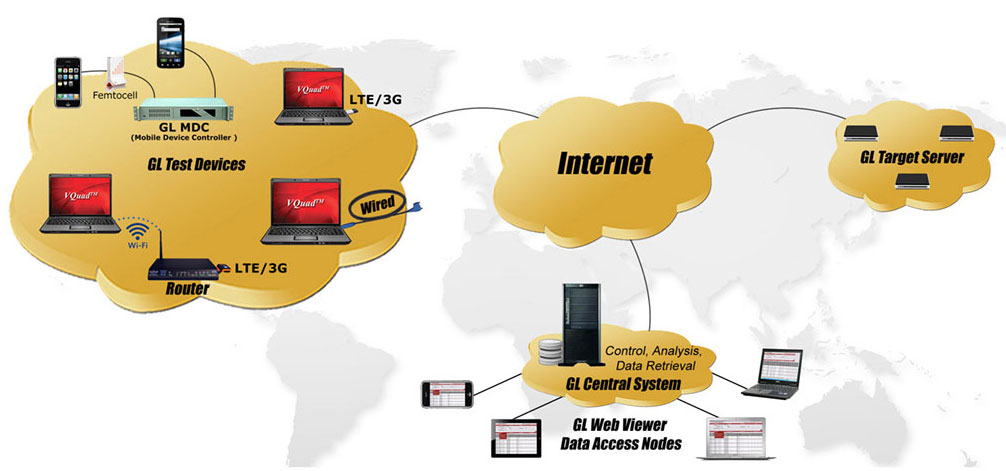HD Platform for Voice, Video and Data Testing

Overview
GL's VQuad™ Probe HD is an all-in-one self-contained probe supporting multiple physical interfaces for connecting to practically any wired or wireless network while automatically performing voice and data testing. This comprehensive hardware probe incorporates all the features of the VQuad™ with Dual UTA HD along with portability and remote accessibility.

The VQuad™ Probe HD is extremely portable, same length as the Dual UTA HD and about twice as high. Two independent devices are supported on the VQuad™ Probe HD for connecting to a variety of endpoints. Remote access to the VQuad™ Probe HD is possible via two on-board GBit Ethernet interfaces. Access using either VQuad™ CLI/API or simply using Windows Remote Desktop (in other words, Keyboard/Mouse not required).
An optional Touchscreen Monitor can connect to the VQuad™ Probe HD via USB. The Touchscreen Monitor provides full control of the VQuad™ Probe HD with included virtual keyboard.
The following PC interfaces are included with the VQuad™ Probe HD:
- 4 USB ports (can be used for Keyboard/Mouse as well as connecting additional Dual UTA HD units)
- 2 GBit Ethernet ports
- Video port (VGA)
- Serial port (COM)
- 128Gb solid-state hard drive
- 8G memory
- Intel Celeron Quad Core, 1.8GHz
There are no moving parts in the VQuad™ Probe HD so reliability and longevity are integral.
Supported Hardware Interfaces
- Mobile Phones:
- Bluetooth®: Works with all Bluetooth® phones for both call control and send/record voice required for Voice Quality and Delay measurements. In addition to Call Control, a variety of Bluetooth® commands can be sent to the mobile device for reporting RSSI, Battery Level, and Network Verification (to name a few). Supports both NB and, for VoLTE, WB audio.
- Mobile Audio Headset Interface for Smartphones: Smartphone Automated Call Control (ACC) cable connects to the mobile phone via 3.5mm Headset interface (or USB-C with adaptor). Supports both call control and send/record voice required for Voice Quality and Delay measurements. Call Control functions include Answer Call, Reject Call, Release Call and Place Call (requires Siri or Google Voice). Also supports Send/Receive SMS via Siri or Google Voice. Supports NB, WB (VoLTE) and SWB audio.
- Mobile Radios with Push-to-Talk functionality: Provides automated radio keying to establish voice path. During the voice call, supports sending/recording voice required for Voice Quality and Delay measurements. Fully automated for bi-directional testing.
- RJ11 FXO (2-wire Analog): Connect to any 2-wire network including PSTN, ATA or G/W. Full Call Control including Offhook/OnHook, Detect Call Progress Tones, CallID and CW CallID detection, Send DTMF Digits, Flash Hook, and support for secondary services as well as multi-stage and conference calling. During established call, send/record voice required for Voice Quality and Delay measurements. Supports both NB and WB (HD) audio.
- Handset Phones (POTS, Digital, and VoIP): Replace the handset of any telephone (POTS, Digital, and VoIP) at the 4-wire Analog RJ22 interface (at the curly cord). Send/record voice required for Voice Quality and Delay measurements. Supports NB, WB and SWB audio.
- 4-wire Analog: Replaces any Tx/Rx headset including PC Headset, Mic/Speaker Headset, HATS (Head and Torso Simulator), and Mobile Phone Headset (to name a few). Send/Record voice required for Voice Quality and Delay measurements. Supports NB, WB, and SWB audio.
Automated Voice Quality Testing
VQuad™ Probe HD supports network-independent Voice Quality Testing on legacy, as well as Next Generation networks. Using a variety of supported interfaces, with the ability to support both NB and WB (HD) audio, Voice Quality can be measured on any network and any device under test. The GL’s Voice Quality analysis supports POLQA (ITU-T P.863)and PESQ (ITU-T P.862) Voice Quality Measurement standards. Along with Voice Quality MOS, additional metrics are returned including Speech Level gain, Noise Level gain, and Speech Activity.
- Voice Quality algorithms including POLQA (ITU-P.863) and PESQ (ITU-P.862)
- Additional VQuad™ Voice tests include Power/Frequency measurements and P.56
- One Way and Round Trip Delay Measurements
- Voice Quality testing on Mobile VoLTE network using Bluetooth® or Smartphone ACC cable
- Voice Quality testing on Mobile Radios with Push-to-Talk functionality
- Voice Quality testing on FXO (2-wire Analog) interfaces with full Call Control Analysis (Success Call, Failed Call, Dropped Call and Path Confirmation)
- Automated testing using VQuad™ scripting
- Remote Accessibility using VQuad™ CLI/API
- Optional GPS receiver for location and accurate time synching (required for One Way Delay measurements)
Automated Data Quality Testing
VQuad™ is enhanced to support Data Testing over any IOS or Android mobile device, and any network including legacy 2G/3G, current generation 4G/LTE, and future 5G. Both Manual and Automated testing is supported with all results sent to the Central Database and accessed using the GL WebViewer™. GL NetTest data tests include TCP, UDP, VoIP, HTTP, FTP, DNS, SMS, and Email.
- Network independent, supports all legacy, current and future networks along with Wifi (basically any method the phone connects to the network)
- Supports both iPhone and Android Mobile devices
- Supports PC Ethernet connection (Wired, Wifi, Broadband)
- Several data tests supported including TCP, UDP, HTTP, FTP, DNS, VoIP, SMS, and Email
- End-to-End SMS and Email Testing over wireless networks
- Remotely perform Data tests, from anywhere in the world, using VQuad™ scripting when connected to the GLNetTestApp running on mobile devices
- Fully automated and remote testing with all results accessible via WebViewer™
Automated Video Quality Testing
VQuad™ can now initiate, control, test, and measure video conferencing services over IP and Wireless networks, using the VQuad™ Video Conference Test solution.
Video Tests can be configured between any two active video clients with flexibility of user-specifying characteristics of the Video test. Results include bi-directional Video and Audio MOS (along with several additional video/audio metrics).
- Fully automated Video Conference testing
- Support for Android, PC and Linux end-points
- Both manual and automated tests supported
- Tests can be run directly from the Android device or remotely and automatically using the VQuad™ scripting
- Configure unlimited test plans with video test parameters including, Codec, Bandwidth, Latency, Frame Rate, Group of Pictures (GoP) Structure, Echo, and Resolution
- Test results include Video MOS, Audio MOS, and A/V MOS along with a variety of analytical and quality metrics
- Fully automated and remote testing with all results accessible via WebViewer™
Additional VQuad™ Tests Supported
VQuad™ Probe HD supports the following additional tests,
- One Way Delay (OWD) and Round Trip Delay (RTD) measurements
- Noise Level measurements
- Fax Emulation over 2-Wire and 4-wire Analog networks
- Echo Measurement Analysis (Line and Acoustic echo)
- Pulse Dial Delay (PDD ) measurements
- Call Control analysis including Failed and Dropped calls
- Automated IVR testing
- Conference bridge testing and analysis
- Drive testing for voice, data and video with real-time mapping (Google Maps)
Other Important Features
- Supports up to 12 independent devices per VQuad™ system
- Each device controlled independently for traffic and call control
- Send/Receive voice files over established calls
- Remote Access for starting/stopping tests along with retrieving results
- Optional VoIP SIP testing with support for Voice Quality and path confirmation
- Optional T1/E1 CAS/PRI with support for Voice Quality
For comprehensive information on the applications, user can refer to Voice, Video and Data Testing Application web page.



 Back to Newsletter Index Page
Back to Newsletter Index Page